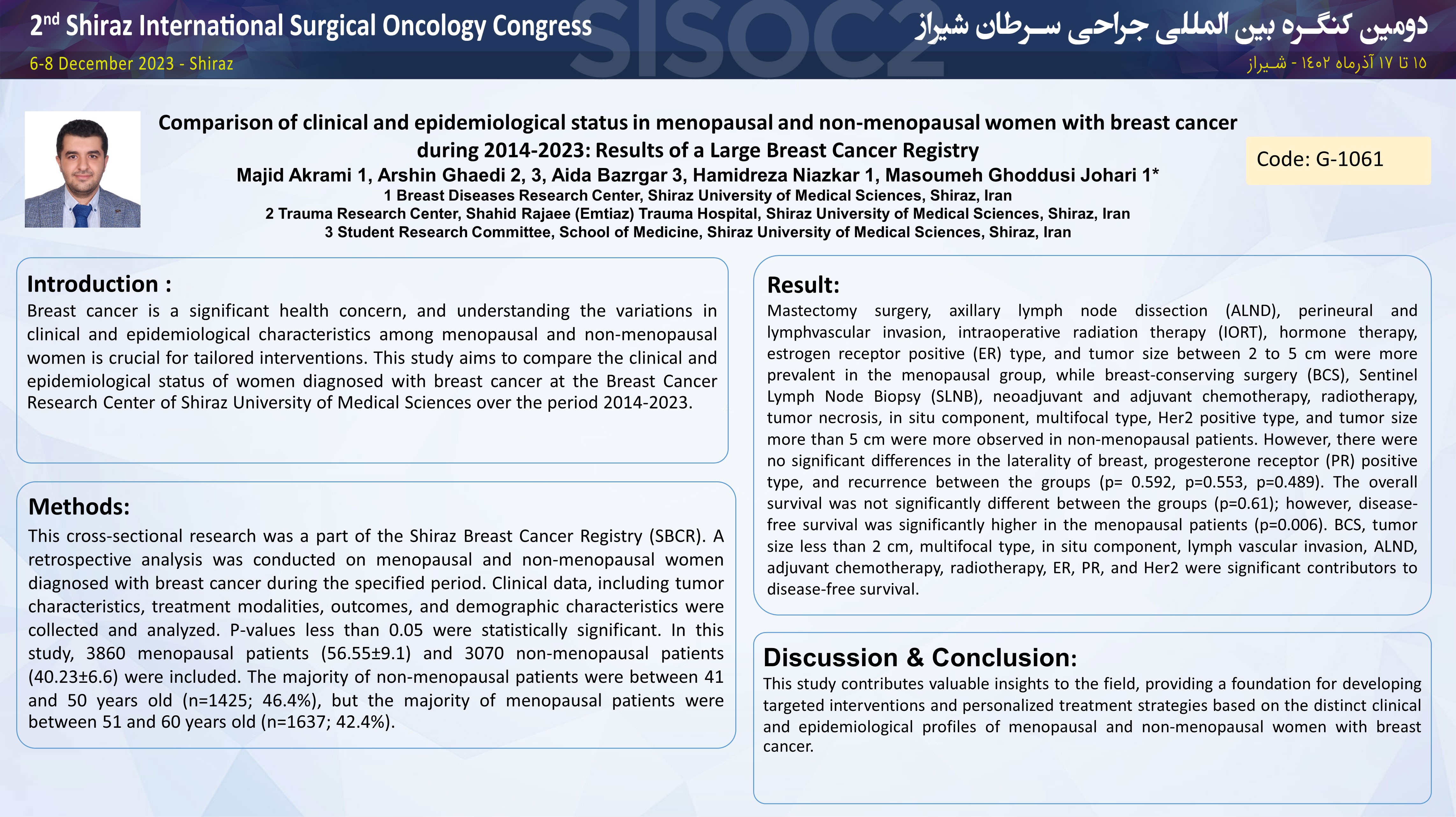Comparison of clinical and epidemiological status in menopausal and non-menopausal women with breast cancer during 2014-2023: Results of a Large Breast Cancer Registry
Code: G-1061
Authors: Majid Akrami , Arshin Ghaedi ℗, Aida Bazrgar, Hamidreza Niazkar , Masoumeh Ghoddusi Johari ©
Schedule: Wednesday 2023-12-06 16:45 on Unit Panel B
Download: Download Poster
Abstract:
Abstract
Background: Breast cancer is a significant health concern, and understanding the variations in clinical and epidemiological characteristics among menopausal and non-menopausal women is crucial for tailored interventions. This study aims to compare the clinical and epidemiological status of women diagnosed with breast cancer at the Breast Cancer Research Center of Shiraz University of Medical Sciences over the period 2014-2023. Methods: This cross-sectional research was a part of the Shiraz Breast Cancer Registry (SBCR). A retrospective analysis was conducted on menopausal and non-menopausal women diagnosed with breast cancer during the specified period. Clinical data, including tumor characteristics, treatment modalities, outcomes, and demographic characteristics were collected and analyzed. P-values less than 0.05 were statistically significant. Results: In this study, 3860 menopausal patients (56.55±9.1) and 3070 non-menopausal patients (40.23±6.6) were included. The majority of non-menopausal patients were between 41 and 50 years old (n=1425; 46.4%), but the majority of menopausal patients were between 51 and 60 years old (n=1637; 42.4%). Mastectomy surgery, axillary lymph node dissection (ALND), perineural and lymphvascular invasion, intraoperative radiation therapy (IORT), hormone therapy, estrogen receptor positive (ER) type, and tumor size between 2 to 5 cm were more prevalent in the menopausal group, while breast-conserving surgery (BCS), Sentinel Lymph Node Biopsy (SLNB), neoadjuvant and adjuvant chemotherapy, radiotherapy, tumor necrosis, in situ component, multifocal type, Her2 positive type, and tumor size more than 5 cm were more observed in non-menopausal patients. However, there were no significant differences in the laterality of breast, progesterone receptor (PR) positive type, and recurrence between the groups (p= 0.592, p=0.553, p=0.489). The overall survival was not significantly different between the groups (p=0.61); however, disease-free survival was significantly higher in the menopausal patients (p=0.006). BCS, tumor size less than 2 cm, multifocal type, in situ component, lymph vascular invasion, ALND, adjuvant chemotherapy, radiotherapy, ER, PR, and Her2 were significant contributors to disease-free survival. Conclusion: This study contributes valuable insights to the field, providing a foundation for developing targeted interventions and personalized treatment strategies based on the distinct clinical and epidemiological profiles of menopausal and non-menopausal women with breast cancer.
Keywords
Breast cancer, menopause, epidemiology, registry
Comments (0)
Post a comment
Post comment is closed by admin.
